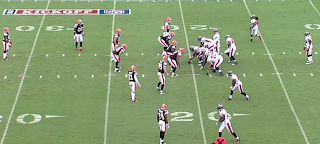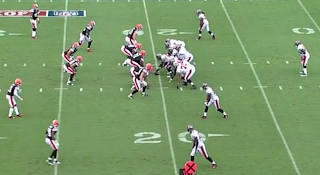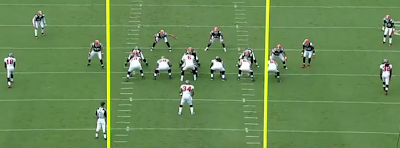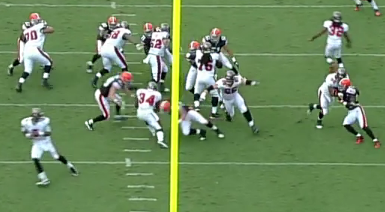C
Cr122
Guest
Vela - Running the Rob Ryan Defense, Part One: Knowing Your Opponents' Hand
Running the Rob Ryan Defense, Part One: Knowing Your Opponents' Hand
Posted by Rafael at Monday, May 16, 2011
In Which Rob Makes the Most of What He's Got
When Jason Garrett was asked in his press tour last week to describe new coordinator Rob Ryan's version of the 3-4, he gave an answer that would have made The Master of Obfuscation, Dwight Eisenhower, proud. Garrett explained at length that Ryan's scheme is different, without ever offering a concrete detail of how.
And how is it different? With an assist from brother Rex, we're going to look at the brother's philosophy of the 3-4, with some early examples from Rob's 2010 Cleveland scheme for examples.
Rex offered a detailed breakdown of his philosophy in a 2005 coaching clinic, where he began at the beginning, stating the objective for any quality defense is to deny the opponent points, while scoring some yourself, creating turnovers and creating superior field position for your offense.
With regard to how this is done, Rex's presentation listed several objectives:
creating a simple, yet multiple scheme, that is easy to learn but difficult for opponents to decipher
creating confusion through pre-snap movement and disguising of intent
pressuring offenses, and dictating rather than reacting to the offense
creating mis-matches
defending the offense's best players when necessary, and;
defending formations the offense prefers
This last quality is emphasized by other successful DCs like New Orleans' Gregg Williams and New England's Bill Belichick, who emphasize taking away an offense's pet plays and forcing them to move successfully and to score working off lesser used and preferred options.
We begin today's review in week one of the 2010 season, where the Browns faced the Tampa Bay Buccaneers. Cleveland lost a slugfest, but Ryan's defense played well in a 17-14 loss. We'll look at Ryan's personnel flexibility and one example of how confident he was in reading and defending Tampa Bay's formations.
A 3-4 with a limp
Ryan leaned heavily on his schemes to hide potential mis-matches. Ryan worked with 3-4 personnel groupings on most early ''base'' downs, but worked in his nickel and dime sets quite a bit on 1st-and-10, pulling a DE and inserting an extra safety, giving a 2 lineman-4 linebackers-5 defensive back package. With both OLBs crowding the line, the Browns showed Josh Freeman a lot of 4-2-5 looks on early downs. Cleveland showed this look on the first play of the game, when Tampa had a base offensive set in the game.
The change up occurred in part because Cleveland was short-handed on the line, enduring injuries to a few of its linemen. Ryan was also trying to move his personnel around and use novelty to get around personnel shortcomings. The Browns lacked pass rushers. Both outside linebackers, Matt Roth and Scott Fujita had 3.5 sacks. Compare this to Dallas, where Demarcus Ware had 15.5 sacks and Anthony Spencer had 5.0. Ryan tried avoiding base sets where his rushers would be easy to identify and negate.
When Ryan zeroed in on a personnel package, he called a daring defense to stop it. Look at this first half play that started a Tampa Bay drive. The Bucs opened in a slot left formation, with tight end Kellen Winslow on the right and two backs in an I-formation. Before the snap, Winslow motioned left, before looping back to the right, while the fullback flexed wide right:

Cleveland is in man-to-man, with both corners, Sheldon Brown and Joe Haden, lined up over the Bucs' receivers.
When Cleveland recognized the spread set created by the flexed fullback, safety T.J. Ward loped over to cover him, while fellow safety Abram Elam walked to a spot inside left OLB Roth:

The corners backed off a bit, giving six and seven-yard cushions, but at the snap, all eleven Browns defenders were within seven yards of the line of scrimmage. Had Freeman run a play-action pass the Browns would have been vulnerable, because they had nobody patrolling the deep middle, as this end-zone shot reveals:

Ryan seemed to know the Bucs would run to their strong side, behind Winslow, because he had Elam and Roth over the TE. With every Bucs lineman covered by a lineman or an inside backer in an odd, two-gap front, one of these edge defenders was going to go unblocked. Winslow went after Elam, turning Roth free. Weakside OLB Scott Fujita was also unblocked and he raced in from the right edge. Fujita and Roth met at the running back and dropped Earnest Graham for a two-yard loss:

The Ryan brothers preach ''calculated, not reckless'' pressure. This play demonstrates that concept. Ryan was willing to expose his deep defense because his preparation made him certain the play would be a run. He was right, and his players created a negative play.
As John Unitas once said of a daring pass, ''it's not risky if you know what you're doing.'' Rob Ryan seems to know.
Running the Rob Ryan Defense, Part One: Knowing Your Opponents' Hand
Posted by Rafael at Monday, May 16, 2011
In Which Rob Makes the Most of What He's Got
When Jason Garrett was asked in his press tour last week to describe new coordinator Rob Ryan's version of the 3-4, he gave an answer that would have made The Master of Obfuscation, Dwight Eisenhower, proud. Garrett explained at length that Ryan's scheme is different, without ever offering a concrete detail of how.
And how is it different? With an assist from brother Rex, we're going to look at the brother's philosophy of the 3-4, with some early examples from Rob's 2010 Cleveland scheme for examples.
Rex offered a detailed breakdown of his philosophy in a 2005 coaching clinic, where he began at the beginning, stating the objective for any quality defense is to deny the opponent points, while scoring some yourself, creating turnovers and creating superior field position for your offense.
With regard to how this is done, Rex's presentation listed several objectives:
creating a simple, yet multiple scheme, that is easy to learn but difficult for opponents to decipher
creating confusion through pre-snap movement and disguising of intent
pressuring offenses, and dictating rather than reacting to the offense
creating mis-matches
defending the offense's best players when necessary, and;
defending formations the offense prefers
This last quality is emphasized by other successful DCs like New Orleans' Gregg Williams and New England's Bill Belichick, who emphasize taking away an offense's pet plays and forcing them to move successfully and to score working off lesser used and preferred options.
We begin today's review in week one of the 2010 season, where the Browns faced the Tampa Bay Buccaneers. Cleveland lost a slugfest, but Ryan's defense played well in a 17-14 loss. We'll look at Ryan's personnel flexibility and one example of how confident he was in reading and defending Tampa Bay's formations.
A 3-4 with a limp
Ryan leaned heavily on his schemes to hide potential mis-matches. Ryan worked with 3-4 personnel groupings on most early ''base'' downs, but worked in his nickel and dime sets quite a bit on 1st-and-10, pulling a DE and inserting an extra safety, giving a 2 lineman-4 linebackers-5 defensive back package. With both OLBs crowding the line, the Browns showed Josh Freeman a lot of 4-2-5 looks on early downs. Cleveland showed this look on the first play of the game, when Tampa had a base offensive set in the game.
The change up occurred in part because Cleveland was short-handed on the line, enduring injuries to a few of its linemen. Ryan was also trying to move his personnel around and use novelty to get around personnel shortcomings. The Browns lacked pass rushers. Both outside linebackers, Matt Roth and Scott Fujita had 3.5 sacks. Compare this to Dallas, where Demarcus Ware had 15.5 sacks and Anthony Spencer had 5.0. Ryan tried avoiding base sets where his rushers would be easy to identify and negate.
When Ryan zeroed in on a personnel package, he called a daring defense to stop it. Look at this first half play that started a Tampa Bay drive. The Bucs opened in a slot left formation, with tight end Kellen Winslow on the right and two backs in an I-formation. Before the snap, Winslow motioned left, before looping back to the right, while the fullback flexed wide right:
Cleveland is in man-to-man, with both corners, Sheldon Brown and Joe Haden, lined up over the Bucs' receivers.
When Cleveland recognized the spread set created by the flexed fullback, safety T.J. Ward loped over to cover him, while fellow safety Abram Elam walked to a spot inside left OLB Roth:
The corners backed off a bit, giving six and seven-yard cushions, but at the snap, all eleven Browns defenders were within seven yards of the line of scrimmage. Had Freeman run a play-action pass the Browns would have been vulnerable, because they had nobody patrolling the deep middle, as this end-zone shot reveals:
Ryan seemed to know the Bucs would run to their strong side, behind Winslow, because he had Elam and Roth over the TE. With every Bucs lineman covered by a lineman or an inside backer in an odd, two-gap front, one of these edge defenders was going to go unblocked. Winslow went after Elam, turning Roth free. Weakside OLB Scott Fujita was also unblocked and he raced in from the right edge. Fujita and Roth met at the running back and dropped Earnest Graham for a two-yard loss:
The Ryan brothers preach ''calculated, not reckless'' pressure. This play demonstrates that concept. Ryan was willing to expose his deep defense because his preparation made him certain the play would be a run. He was right, and his players created a negative play.
As John Unitas once said of a daring pass, ''it's not risky if you know what you're doing.'' Rob Ryan seems to know.
